Fs driver что это
Обновлено: 06.07.2024
Как в среде Windows сделать возможным доступ к разделу диска или съёмному носителю с файловыми системами Ext2/3/4 ? Если, к примеру, на компьютере есть ещё и вторая система Linux. И с её данными необходимо поработать из среды Windows. Или другой пример – когда внутри Windows смонтированы виртуальные диски с установленными на виртуальные машины системами Linux или Android . С Ext2/3/4 Windows нативно не умеет работать, ей для этого нужны сторонние средства. Что это за средства? Рассмотрим ниже таковые.
***
Тройка первых средств сделает возможным только чтение устройств информации с Ext2/3/4 . Последнее решение позволит и читать, и записывать данные. Все рассмотренные ниже средства бесплатны.
Что значит «слетели драйвера»?
Это значит, что компьютер не может найти файлы с инструкциями от какого-то устройства. Так бывает при обновлениях системы, заражении вирусом или просто кто-то случайно мог удалить нужные файлы или папку целиком.
Решение простое: берёте заново драйвер с официального сайта или тот, который шёл в комплекте с устройством, и запускаете программу-установщик заново. А она уже сама разберётся, каких файлов не хватает, и настроит всё заново.
В чём проблема с драйверами
Проблема в том, что часто производители не делают новые драйверы для старого оборудования. Например:
Есть диджейский контроллер Numark NS7 — это профессиональное оборудование для диджеев и артистов, оно стоит дорого и нужно примерно 100 тысячам человек на всей планете.
Когда контроллер только вышел, компания Numark выпускала драйвера на все свежие операционные системы, проблем с совместимостью не было.
Потом аппарат сняли с производства, поддержку прекратили. Последняя версия драйверов, которую выпустил Numark, — для Windows 10 и MacOS 10.12 (Sierra). С тех пор у Windows вышло большое обновление до 11, а MacOS обновился раз пять. Причём последние две версии сделаны для процессоров Apple, и уже нет надежды, что Numark обновит драйверы для этой архитектуры.
Так что, если вам достался этот редкий профессиональный прибор, вы вынуждены сидеть на древней MacOS Sierra, которая стремительно перестаёт поддерживаться современным софтом.
What Ext2 revisions and Ext2 feature bits does the Ext2 driver support?
Revision 0 (Linux Kernel 2.2 and prior) and revision 1 (dynamic revision, Linux Kernels higher than 2.2) are supported.
Revision 1 (dynamic revision) implements feature bits as a kind of version control. These feature bits indicate whether an Ext2 file system residing on a disk has particular feature properties. Almost all feature bits are determined at the time when the Ext2 file system is created. Therefore most of the possible feature bits correspond to the -O switch of the mke2fs tool of Linux. (mke2fs is the "formatting tool" for Ext2 file system and creates such a file system. There is also a tune2fs tool for modifying feature bits of an Ext2 file system.)
The current version of the Ext2 file system driver (ext2fs.sys version 1.12) supports the following feature bits of the Ext2 file system:
Does the fsutil tool of Windows control the trim support of the Ext2 file system driver?
(Windows 7/Server 2008 R2 or newer.)
No, fsutil does not control the trim support of the Ext2 file system driver. Example for NTFS: If entering
fsutil behavior query disabledeletenotify
at the command prompt yields "DisableDeleteNotify = 0", the trim support for NTFS is enabled in general; trim operations will be performed if there is a solid state drive (SSD) which supports trim operations.
Fsutil merely checks or modifies at the registry key
HKEY_LOCAL_MACHINE\SYSTEM\CurrentControlSet\Control\FileSystem
the registry value
DisableDeleteNotification
The ext2fs.sys driver of the Ext2 IFS software does not utilize this registry value. If you want to disable the trim support of ext2fs.sys, you can modify at the registry key
HKEY_LOCAL_MACHINE\SYSTEM\CurrentControlSet\Services\Ext2fs\Parameters
the registry value
DisableDeleteNotification
If that (DWORD-) value exists and is not equal to 0x0000 the trim support of ext2fs.sys is disabled. (Changes will take effect on next reboot.)
The default is trim support enabled; if in doubt you should not disable it. The ext2 driver does not attempt to issue any trim operation on drives which are not able to perform a trim operation. An unnecessary overhead due to trim operations is avoided in this way.
Does the Ext2 driver access Ext4 volumes?
Unfortunately the Ext2 driver is not able to access Ext4 volumes at all.
What files does the setup program install?
Ext2 Installable File System For Windows
It provides Windows NT4.0/2000/XP/Vista/7/8/8.1/Server 2003/2008/2008 R2/2012/2012 R2 with full access to Linux Ext2 volumes (read access and write access). This may be useful if you have installed both Windows and Linux as a dual boot environment on your computer.
The "Ext2 Installable File System for Windows" software is freeware.

If you currently have Windows running and you realize that you need some files for your work which you have stored on an Ext2 volume of your Linux installation, you no longer have to shut down Windows and boot Linux!
Furthermore, Windows will now be able to handle USB memory sticks and floppy disks which have been formatted with an Ext2 file system.
Linux Ext3 volumes can also be accessed. To do that, please read the FAQ section.


It installs a pure kernel mode file system driver Ext2fs.sys, which actually extends the Windows operating system to include the Ext2 file system. Since it is executed on the same software layer at the Windows operating system core like all of the native file system drivers of Windows (for instance NTFS, FASTFAT, or CDFS for Joliet/ISO CD-ROMs), all applications can access directly to Ext2 volumes. Ext2 volumes get drive letters (for instance O:). Files, and directories of an Ext2 volume appear in file dialogs of all applications. There is no need to copy files from or to Ext2 volumes in order to work with them.
Does the Ext2 driver access Ext3 volumes?
The Ext3 file system is the Ext2 file system which has been extended by journaling. Ext3 is backward-compatible to Ext2 - an Ext3 volume can be mounted and used as an Ext2 volume. Just as older Linux Kernels which do not know the Ext3 file system can mount Ext3 volumes (as Ext2 volumes), the Ext2 file system driver ext2fs.sys for Windows incorporated in this software package can do it without any problems, too. Of course you do not take advantage of the journaling of the Ext3 file system if you mount it as an Ext2 file system.
If you mount an Ext3 file system as an Ext2 file system and the file system is not cleanly dismounted, (e.g. due to a system crash), you have to run the e2fsck tool. (Linux does it automatically.) Running e2fsck can take several hours on large volumes. You do not benefit from journaling the Ext3 file system, because you have to run e2fsck.
If you mount an Ext3 file system as an Ext3 file system (journaling) and the file system is not cleanly dismounted due to a system crash, things are much better: When the volume is mounted next time as an Ext3 file system, a replay of the journal will be done, after which the file system will be consistent. You need not run e2fsck. (If you run e2fsck nevertheless, it won't find any errors of the Ext3 file system, because there will not be any errors after replaying the journal.)
If a volume is mounted as Ext3 file system, any new data is first completely written into the journal, and then into the file system. This is also called a transaction. Finally, the data is removed from the journal. So a journal only contains data when you are writing to the file system. After a clean dismount of the Ext3 file system, the journal is empty.
When the Linux kernel mounts an Ext3 file system, it first checks whether the journal contains complete transactions (not written yet due to a prior crash). If there are any, it does the already mentioned replay of the journal, which means that all data of the journal is written to the file system, and any data will be removed from it. So a replay always repairs any damage caused by a prior crash.
With the described way of writing the journal and the file system's data and with a replay of the journal after a crash, consistency of the file system is always achieved. Thus, e2fsck will not find any error.
The Ext2 file system driver of the Ext2 IFS software will refuse mounting an Ext3 file system which contains data in its journal, just like older Linux kernels which have no Ext3 support. In this way data loss and damaging the file system is avoided when the journal is subsequently replayed. So you can access only those Ext3 volumes with the Ext2 IFS software which have been cleanly dismounted beforehand.
Сложное оборудование
Ещё бывает так, что оборудование хоть и стандартное, но сложное, например, видеокарта или принтер. Каждый производитель добавляет свои функции и технологии, которые считает нужными, и чаще всего они не совпадают с другими. Если подключить такое устройство к компьютеру, то компьютер, скорее всего, разберётся, что именно в него воткнули, то как с этим работать — неизвестно.
Здесь тоже нужны драйверы — они идут или в комплекте с устройством на компакт-диске или их качают с официального сайта производителя. Чем сложнее устройство, тем больше вероятность, что без установки дополнительных драйверов оно работать не будет.
Например, если у вас навороченная видеокарта, вы вставляете её в компьютер и сначала видите странную огромную картинку с низким разрешением. Это значит, что компьютер пока не нашёл драйверов на эту карточку и запустил её в «режиме совместимости» — то есть в том режиме, в котором он точно сможет ей управлять. Но возможности видеокарты будут сильно порезаны, пока мы не установим нужные нам драйверы.
Features
Detailed list of features:
- Supports Windows NT 4.0, Windows 2000, Windows XP, Windows Vista, Windows 7, Windows 8, Windows 8.1, Windows Server 2003, Windows Server 2008, Windows Server 2008 R2, Windows Server 2012, and Windows Server 2012 R2.
- Supports both the 32 bit x86 and the 64 bit x64 platform. Supports the 64 bit Itanium Processor Family (IPF) as well.
- Includes drivers with a digital signature for Windows Vista x64 or higher.
- All operations you would expect: Reading and writing files, listing directories, creating, renaming, moving and deleting files or directories, querying and modifying the volume's label.
- Has trim support for solid state drives (SSD) on Windows 7/Server 2008 R2 or higher.
- UTF-8 encoding.
- Large inodes.
- Supports block sizes up to 64KB.
- Files larger than 2 GBytes. (Please read the FAQ section, too.)
- Supports hash indexed (htree) directories (utilizes the so-called dir_index feature of Ext3).
- Supports some Ext4 features: dir_nlink feature, huge_file feature, and the uninit_bg feature which includes group descriptor checksums.
- Implements the Ext4 Multiblock Allocator which improves the performance on Ext2 or Ext3 as well by a superior efficiency upon block allocation and by minimizing fragmentation of the volume.
- Full plug-n-play functionality. When a drive is removed, the corresponding drive letter is deleted.
- Supports use of the Windows mountvol utility to create or delete drive letters for Ext2 volumes (except on Windows NT 4.0). This is useful for scripts. (Please read the FAQ section, too.)
- A global read-only option is provided.
- File names that start with a dot "." character or end with "
The file system driver Ext2fs.sys caches file data and the file system's meta data such as directories and all the on-disk structures of the Ext2 file system. (It uses the file cache of the Windows operating system.) Therefore it is performant. The level of sophistication of the Ext2 file system driver implementation is comparable to Windows native file system drivers.
The "Ext2 Installable File System" software package is distributed as a single executable solution, complete with all of the features. It is a setup wizard which installs and configures the Ext2 file system driver. (The screenshots section contains some images of it.) If you wish to uninstall the software, select "Add/remove Software" from the Control Panel.
Furthermore, "IFS Drives" is installed at the computer's control panel, which allows you to assign drive letters to Ext2 volumes. (The screenshots section section contains an image of it.)
Windows is a trademark of Microsoft Corporation. Linux is a trademark of Linus Torvalds. All other trademarks and service marks are the property of their respective owners.
Ext2 Installable File System For Windows
Creating, modifying and removing of drive letters is very simple. Please use the "IFS Drives" item, which has been installed on the system's control panel.


It shows a partition scheme and enables you to administrate drive letters for all non-Windows partitions, including all the Ext2 volumes. (That partition scheme is shown by the setup application of this software package, too.) You must have administrator rights.
Drive letters may also be configured with the Windows mountvol utility. See also section "Can drive letters also be configured from scripts?".
4. Драйвер поддержки Ext2Fsd
Программа Ext2Fsd – это драйвер Ext2/3/4 , он реализует поддержку этих файловых систем на уровне операционной системы. С разделами диска и накопителями, форматированными в эти файловые системы, можно работать как с обычными, поддерживаемыми Windows устройствами информации в окне проводника или сторонних программ. Драйвер позволяет и считывать, и записывать данные.
Скачиваем последнюю актуальную версию Ext2Fsd.
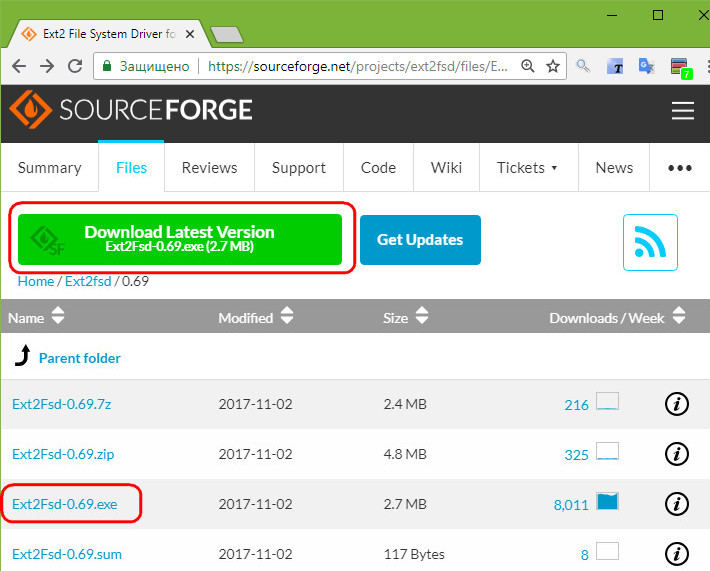
При установке активируем (если для длительной работы) три предлагаемых чекбокса:
• 1 - Автозапуск драйвера вместе с Windows;
• 2 - Поддержка записи для Ext2;
• 3 - Поддержка форматирования для Ext3.
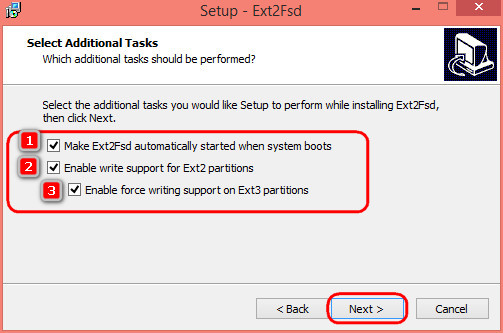
На предфинишном этапе активируем опцию запуска окошка диспетчера драйвера - Volume Manager - с попутным присвоением устройствам информации с Ext2/3/4 буквы диска.
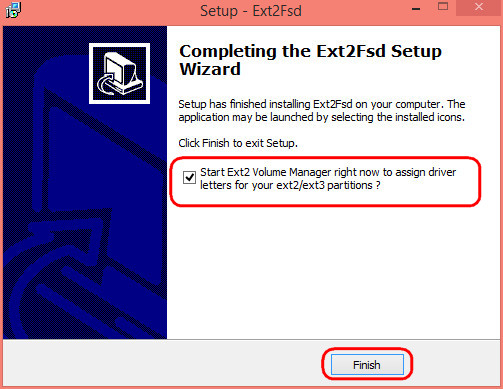
В окошке открывшегося Volume Manager увидим носитель с уже присвоенной буквой. Например, в нашем случае носителю с Ext4 задана первая свободная буква F.
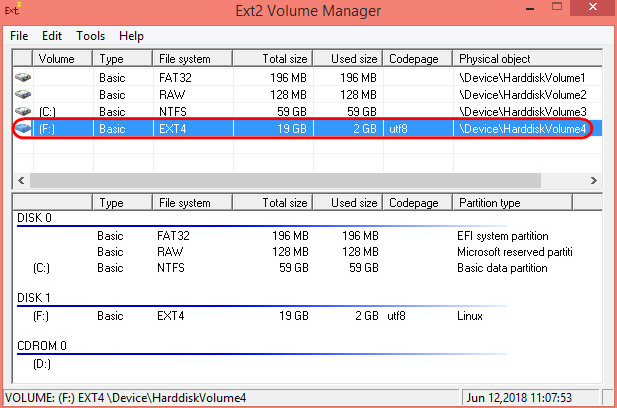
Теперь можем работать с диском F в окне проводника.
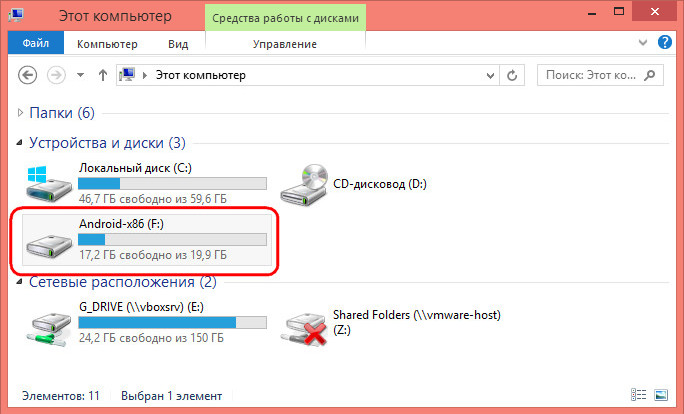
Присвоить букву новым подключаемым устройствам с Ext2/3/4 можно с помощью контекстного меню, вызываемого на каждом из отображаемых в окне Volume Manager устройств. Но просто при присвоении буквы диска такое устройство не будет отображаться после перезагрузки Windows, это решение только для одного сеанса работы с компьютером. Чтобы сделать новое устройство с Ext2/3/4 постоянно видимым в среде Windows, необходимо двойным кликом по нему открыть настроечное окошко и установить постоянные параметры подключения. Во второй графе нужно:
• Для съёмных носителей активировать чекбокс, обозначенный на скриншоте цифрой 1, и указать букву диска;
• Для внутренних дисков и разделов активировать чекбокс, обозначенный на скриншоте ниже цифрой 2, и также указать букву диска.
Далее применяем всё только что настроенное: нажимаем внизу «Apply».
What is the Huge File Feature and how is it configured?
Linux kernels version 2.6.19 or higher store files larger than 2 TBytes if they are mounting the volume as Ext4 volume and the feature bit
EXT4_FEATURE_RO_COMPAT_HUGE_FILE
is set.
Setting this feature bit causes old Linux Kernels, which do not support huge files (version prior 2.6.19), to mount the volume as a read-only volume. This also occurs if the Linux Kernel mounts the volume as Ext2 or Ext3. If the volume is the root volume of an old Linux installation, its Linux Kernel will become inoperable (it will enter the maintenance mode on booting).
If the huge file feature is cleared, any attempt to store a file larger than 2 TBytes fails. The Linux Kernel does not set the EXT4_FEATURE_RO_COMPAT_HUGE_FILE feature subsequently. Usually EXT4_FEATURE_RO_COMPAT_HUGE_FILE is either cleared or set by the mke2fs tool on creation of the Ext2 file system.
The Ext2 file system driver ext2fs.sys is able to set the huge file feature, unlike the Linux Kernel.
The setup wizard of this software asks the user whether the huge file feature feature should be enabled and configures the file system driver ext2fs.sys for Windows according to the choice made by the user. If in doubt, disable the huge file feature. If you choose the simple setup option, the huge file feature is disabled.
To check or modify whether the huge file feature of ext2fs.sys is enabled, it is configured at the registry key
HKEY_LOCAL_MACHINE\SYSTEM\CurrentControlSet\Services\Ext2fs\Parameters
through the registry value
TriggerHugeFileFeature
If this (DWORD-) value exists and is not equal to 0x0000 the huge file feature is enabled. (Changes will take effect on next reboot.)
Драйверы нужны только на Windows?
Драйверы нужны на всех компьютерах и для всех операционных систем. Но некоторые операционки идут с кучей драйверов в комплекте, а у других этот набор более скромный.
Общее правило для 2021 года такое: большая часть оборудования, которое нужно для обычной офисной работы, подключится к любому компьютеру без необходимости что-то устанавливать. Операционка сама поймёт, что это за устройство, и, скорее всего, у неё уже будут драйверы.
А вот какое-то более сложное оборудование (например, профессиональная аудиокарта или видеокамера) потребуют установки драйверов от производителя.
How do I uninstall the Ext2 IFS software?
Use the "Add/Remove Programs" item in the control panel to uninstall the "Ext2 IFS 1.12 for Windows" software.
Can drive letters also be configured from scripts?
With version 1.11 of the Ext2 IFS software, drive letters can be configured with the Windows mountvol utility (except on Windows NT 4.0). This is useful if you want to control them from a script.
The mountvol utility is used just as if the drive letters would correspond to native Windows volumes, regardless of whether the volumes are native Windows volumes or Ext2/Ext3 ones.
First create a drive letter, for example X:, for a given Ext2/Ext3 volume with the "IFS Drives" item in the control panel in order to conveniently identify it in the following steps:
Use the Windows mountvol utility in order to identify the persistent volume name of the volume (replace X : with the actual drive letter):
mountvol X:\ /L
Now mountvol will report the persistent volume name (example):
\\?\Volume
The persistent volume name of a native volume of Windows remains valid unless Windows is reinstalled again. The persistent volume name of a volume that is managed by Ext2 IFS remains valid as long as the Ext2 IFS software remains installed.
You can use a known persistent volume name for a specific volume in order to create a new drive letter:
mountvol X:\ \\?\Volume
You can delete a drive letter with
mountvol X:\ /D
Что такое драйвер
Драйвер — это программа, которая работает как инструкция для операционной системы. Драйвер объясняет операционке, как пользоваться каким-то устройством.
Устройство — это то, что физически подключается к компьютеру:
- видеокарта,
- мышь,
- криптотокен,
- монитор,
- сканер,
- джойстик для игр.
Драйвер рассказывает компьютеру, как этим железом пользоваться, что оно умеет, какие команды понимает и как это железо могут использовать другие программы.
👉 Технически драйвер — это программа, которая висит в памяти компьютера всё время, пока компьютеру нужно это устройство.

What about block sizes up to 64KB?
The Ext2/Ext3/EXT4 implementation of the Linux Kernel can access block sizes of the file system up to the page size of the processor architecture. If the file system of a volume has a block size which is larger than the page size, the Linux Kernel can't access the volume. The page size of the Linux Kernel is:
- 4KB on x86 (32-bits),
- 4KB on x64 (AMD64/Intel EM64T),
- 4KB, 8KB, 16KB, or 64KB on IA64 (Itanium Processor Family, IPF), determined by the configuration while compiling the Linux Kernel.
It means that the Linux kernel is not able to access Ext2/Ext3/Ext4 volumes that have a block size larger than 4KB on the common x86 and x64 processors. (This limitation does not apply for the utilities of the e2fsprogs, for example, e2fsck or mke2fs. You can create and check volumes. The mke2fs utility reports a warning when you are creating a file system which the Linux Kernel isn't able to mount.)
The Ext2 file system driver of the Ext2 IFS software is able to access volumes which have a block size larger than the page size on Windows. The page size is on Windows:
- 4KB on x86 (32-bits),
- 4KB on x64 (AMD64/Intel EM64T),
- 8KB on IA64 (Itanium Processor Family, IPF).
The Ext2 file system driver works correctly on block sizes larger than the page size of Windows, but a performance penalty may arise when allocating new blocks while writing a file or directory. Since Ext2 is a file system with sparsing, a block for a file is allocated when an application writes any non-zero data bytes. If the block size is larger than the page size, the Ext2 driver has to do additional write operations on disk in order to zero out partial areas of any block. The Ext2 driver includes some optimization in order to avoid the performance penalty in some circumstances:
- A file is being written in sequential manner (both cached or non-buffered).
- The file is a paging file (a file "pagefile.sys", which Windows swaps virtual memory to).
If you want to just access some file on an external hard disk drive, you can likely deal with the performance penalty. If you are using a fixed hard disk drive on your computer, you shouldn't use a volume which has a block size larger than the page size.
To conclude, the block size capabilities of the Ext2 file system driver only give a benefit if you are accessing volumes used with some uncommon hardware, for example, an Itanium box, or, not mentioned yet, a MIPS embedded computer, and others.
Что такое драйвер и зачем он нужен
«Слетели драйвера», «У меня нет драйверов на принтер», «Видеокарте нужны драйвера» — если вам непонятно, что это значит и на что влияют драйверы, то эта статья для вас.
2. Плагин для Total Commander DiskInternals Reader
Любители популярного Total Commander могут извлекать данные Linux или Android внутри Windows с помощью этого файлового менеджера. Но предварительно установив в него специальный плагин. Один из таких плагинов - DiskInternals Reader, он умеет подключать и читать устройства информации, форматированные в Ext2/3/4 , Fat/exFAT , HFS/HFS+ , ReiserFS . Загружаем плагин, распаковываем его архив внутри Total Commander, подтверждаем установку.
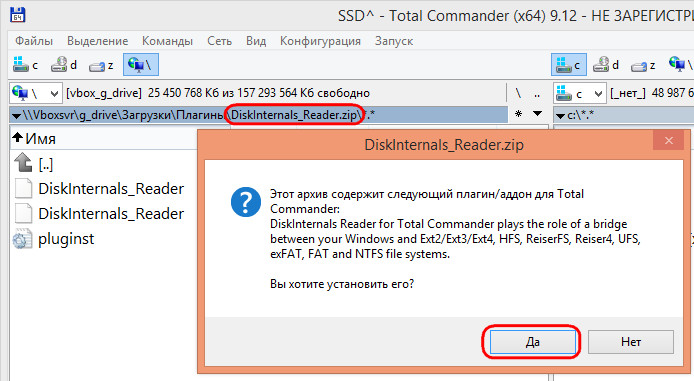
Запускаем Total Commander (важно) от имени администратора. Заходим в раздел «Сеть / FS плагины». Нажимаем «DiskInternals Reader».
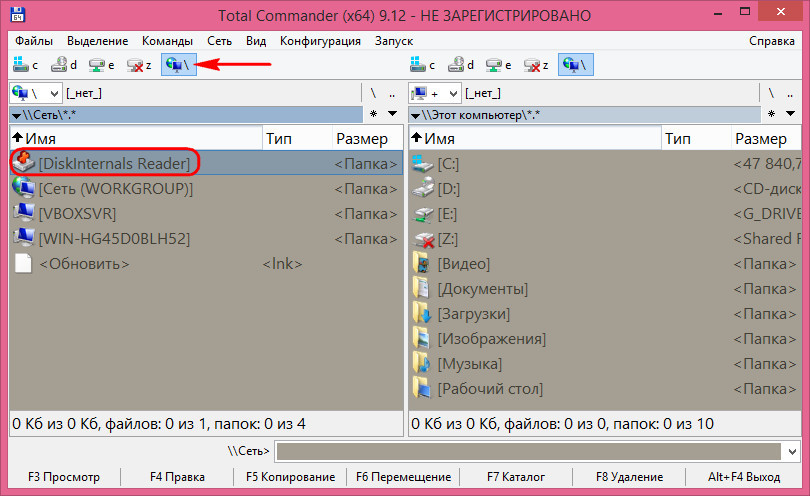
Здесь, наряду с прочими разделами диска и носителями, будет отображаться тот, что с Ext2/3/4 .
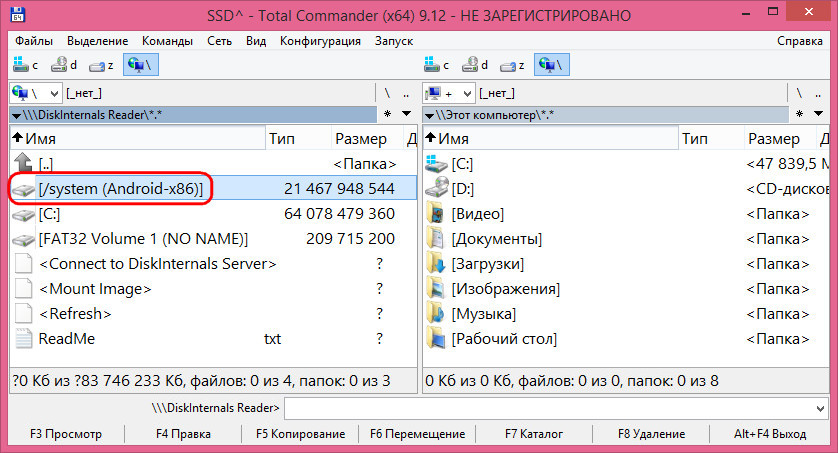
Данные копируются традиционным для Total Commander способом – клавишей F5 на вторую панель.
3. Плагин для Total Commander ext4tc
Упрощённая альтернатива предыдущему решению – ext4tc, ещё один плагин для Total Commander. Он может подключать для чтения устройства информации, форматированные только в Ext2/3/4 . Скачиваем плагин, распаковываем его архив внутри файлового менеджера, запускаем установку.
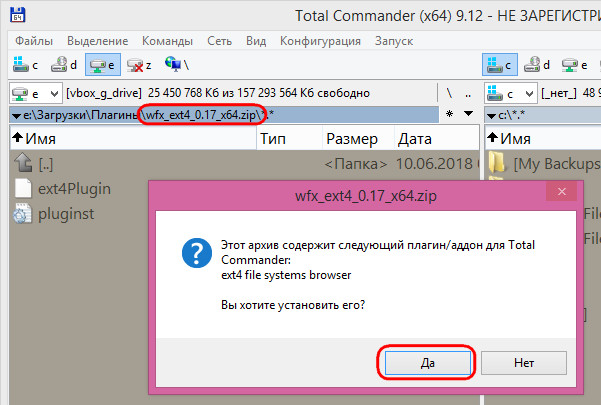
Запускаем Total Commander (важно) от имени администратора. Кликаем «Сеть / FS плагины». Заходим в «ext4plugin».
При необходимости копирования данных используем обычный способ с клавишей F5 .
What is the dir_nlink Feature and how is it configured?
Linux kernels version 2.6.23 or higher are able to store 65000 or more subdirectories within a directory if they are mounting the volume as Ext4 volume: They set a feature bit
EXT4_FEATURE_RO_COMPAT_DIR_NLINK
the first time 65000 subdirectories are created within a directory.
Setting this feature bit causes old Linux Kernels, which do not support the dir_nlink feature (prior to version 2.6.23), to mount the volume as a read-only volume. This also occurs if the Linux Kernel mounts the volume as Ext2 or Ext3. If the volume is the root volume of an old Linux installation, its Linux Kernel will become inoperable (it will enter the maintenance mode on booting).
The Ext2 file system driver ext2fs.sys for Windows has to behave exactly like Linux kernels to become compatible with the Linux file system Ext2. As the behaviors of old and new Linux Kernels with regard to the dir_nlink feature are mutually exclusive, the Ext2 file system driver ext2fs.sys for Windows is configurable, to behave like an old Linux Kernel (prior 2.6.23) or a new Linux Kernel (2.6.23 or higher).
The setup wizard of this software asks the user whether the dir_nlink feature should be enabled and configures the file system driver ext2fs.sys for Windows according to the choice made by the user. If in doubt, disable the dir_nlink feature. If you choose the simple setup option, the dir_nlink feature is disabled.
To check or modify whether the dir_nlink feature of ext2fs.sys is enabled, it is configured at the registry key
HKEY_LOCAL_MACHINE\SYSTEM\CurrentControlSet\Services\Ext2fs\Parameters
through the registry value
TriggerDirNLinkFeature
If this (DWORD-) value exists and is not equal to 0x0000 the large file feature is enabled. (Changes will take effect on next reboot.)
What limitations arise from not maintaining access rights?
The current version of the Ext2 file system driver does not maintain access rights. All users can access all the Ext2 volumes that a drive letter is created for. For example, if a drive letter has been created for an Ext2 volume, which is the root volume of a Linux installation, you can simply read and modify files such as /etc/passwd and /etc/shadow. User names are readable and passwords of these users can be quite easily cracked and modified!
Therefore the current Ext2 file system driver does not fit for installations which require restrictive rights policies. It should be sufficient for your computer at home, which is used by one or a few users only. Furthermore, you should create drive letters for a root volume of a Linux installation only if you know exactly what you are doing.
1. Программа DiskInternals Linux Reader
Простенькая программка DiskInternals Linux Reader – это примитивный файловый менеджер, сделанный по типу штатного проводника Windows, с поддержкой файловых систем Ext 2/3/4 , Reiser4 , HFS , UFS2 . В окне программы увидим разделы и устройства с Linux или Android.
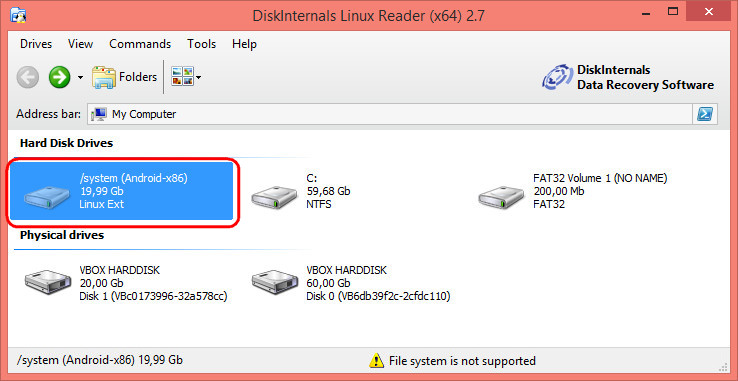
Для копирования необходимо выделить папку или файл, нажать кнопку «Save».
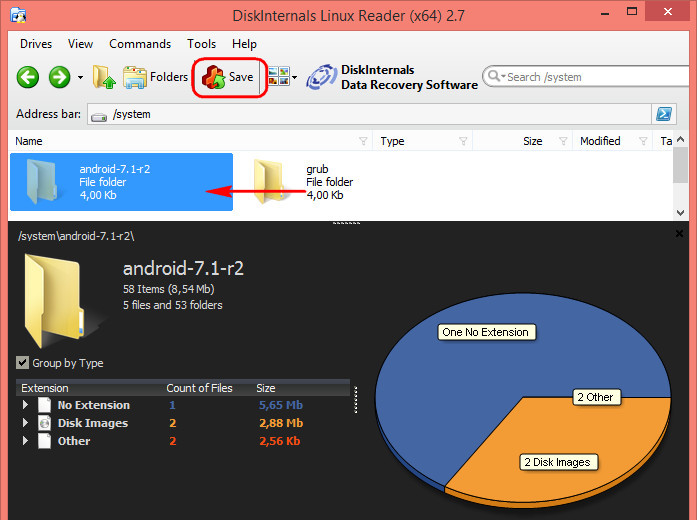
Затем указать путь копирования.
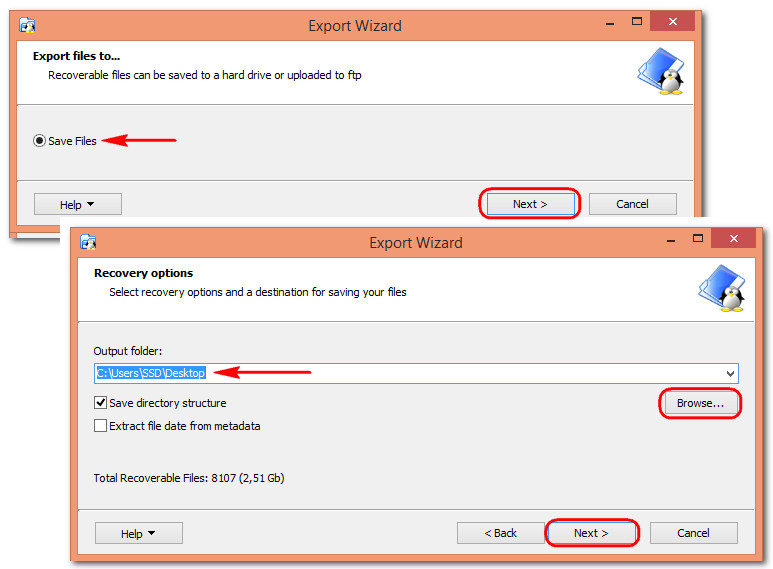
What is the Large File Feature and how is it configured?
Linux kernels version higher than 2.2 allow storing files larger than 2 GBytes on Ext2 volumes: They set a feature bit
EXT2_FEATURE_RO_COMPAT_LARGE_FILE
the first time such a large file is stored.
But this set feature bit causes old Linux Kernels, which do not support large files (version 2.2 or prior), mounting the Ext2 volume as a read-only volume. If that volume is the root volume of an old Linux installation, its Linux Kernel will become inoperable (it will enter the maintenance mode on booting).
The Ext2 file system driver ext2fs.sys for Windows has to behave exactly like Linux kernels to become compatible with the Linux file system Ext2. But the behavior of old and new Linux Kernels regarding to large files excludes each other, so the Ext2 file system driver ext2fs.sys for Windows is configurable whether it behaves like an old Linux Kernel (2.2 or prior) or a new Linux Kernel (higher than 2.2).
The setup wizard of this software asks the user whether the large file feature should be enabled and configures the file system driver ext2fs.sys for Windows according to the choice made by the user. If you have a recent Linux distribution, you should enable the large file feature. If you choose the simple setup option, the large file feature is enabled.
If you want to check or modify whether the large file feature of ext2fs.sys is enabled, it is configured at the registry key
HKEY_LOCAL_MACHINE\SYSTEM\CurrentControlSet\Services\Ext2fs\Parameters
by the registry value
TriggerLargeFileFeature
If that (DWORD-) value exists and is not equal to 0x0000 the large file feature is enabled. (Changes will take effect on next reboot.)
Известное и неизвестное железо
Операционная система в компьютере знает и умеет многое, в том числе и работать со стандартным оборудованием. Стандартным — это значит тем, которое предоставляет стандартные возможности.
Например, клавиатура, мышь или веб-камера — это стандартное оборудование, потому что независимо от производителя они делают примерно одно и то же.
Разработчики операционной системы знают про такое оборудование, поэтому могут написать стандартные драйверы, которые подойдут к большинству устройств. Именно поэтому мы можем купить в магазине новую мышь и просто подключить её к компьютеру без установки дополнительных программ — операционная система сама разберётся, что делать.
Но бывает так, что разработчики добавили в устройство нестандартные возможности: переназначение сочетаний клавиш, сделали мышь с несколькими колёсиками или встроенный лазерный дальномер в видеокамеру. В этом случае компьютер не разберётся, как этим всем пользоваться, потому что в стандартных драйверах про это ничего нет.
В таких случаях разработчики устройств пишут свой драйвер, который объяснит компьютеру, как пользоваться всеми возможностями устройства. Этот драйвер нужно будет установить.
Читайте также:

